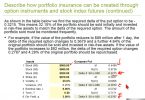enjofaes
Active Member
Hi @David Harper CFA FRM & @Nicole Seaman,
I'm reviewing chapter 16 of book 4 and came across this example in the instructional video and got confused:

In this example the delta becomes more negative and part of the portfolio should be sold.
However I wrote down in previous part of the video: Negative portfolio delta: to hedge we purchase shares.
In the examples from dynamic hedging by Hull in contrast, a positive delta is reported when writing the option and the market maker then purchases shares to dynamically hedge.
So when exactly do we buy or sell shares. When delta is negative or positive?
My intuition says: we short shares when delta is positive and buy shares when it's negative. But then I don't understand the example above or the signs of delta in the Hull dynamic hedge example.
I'm reviewing chapter 16 of book 4 and came across this example in the instructional video and got confused:

In this example the delta becomes more negative and part of the portfolio should be sold.
However I wrote down in previous part of the video: Negative portfolio delta: to hedge we purchase shares.
In the examples from dynamic hedging by Hull in contrast, a positive delta is reported when writing the option and the market maker then purchases shares to dynamically hedge.
So when exactly do we buy or sell shares. When delta is negative or positive?
My intuition says: we short shares when delta is positive and buy shares when it's negative. But then I don't understand the example above or the signs of delta in the Hull dynamic hedge example.
Last edited:

